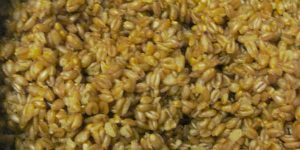
Spelt (Triticum spelta) belongs to the 'grass family'. It is an ancient grain, with records of it's use more than 5,000 years ago.
Just like quinoa, millet, and amaranth, spelt has not been manipulated to meet manufacturing needs. Our body recognizes it as a food.
Spelt kernels or berries, as they are sometimes called, are the plump seeds of the Spelt plant, before it has been ground to make flour.
Spelt is believed to be better tolerated than any other grain and is a nutritious, tasty alternative for most wheat-sensitive people:
- It contains more protein than wheat, including all 8 essential amino acids. These amino acids support good cell maintenance.
- The fiber in Spelt helps blood to clot properly and helps to lower cholesterol.
- Spelt is high in several B vitamins, primarily B2, niacin and thiamin.
- Spelt contains "the anti-neoplastic vitamin B17", which supports the body's cancer fighting system.
- It also contains manganese, copper and zinc.
- Spelt is a great source of fiber and is higher in protein than modern wheat varieties.
I know people with wheat sensitivities who eat Spelt without issue. Many folks who cannot tolerate wheat, enjoy Spelt kernels, or products produced with Spelt flour. Spelt provides a more complete nutritional 'picture' because, unlike wheat, it has not been heavily hybridized for higher yields. Essentially all modern wheat is genetically modified, with the result that many people cannot digest it ~ largely due to it's high gluten content. If you or family members are gluten intolerant, wanting to learn more about eating Gluten-free, or if you're like me... and just want to limit wheat for 101 reasons, experiment with Spelt! It may be a super addition to your healthy life.
People living with Celiac issues should NOT eat Spelt as it does contain gluten.
The gluten in Spelt is more like the old wheat varieties; is recognized by the body and is easily digested by most people. The Spelt's gluten is water-soluble, degrades with heat and is easily broken down by chewing action.
In fact, Spelt is known to help people with arthritis, Lyme's disease, behavioural issues, skin irritations, irritable bowel syndrome and those who suffer with migraines. People with a wide range of digestive system upsets report that they feel better without wheat and using Spelt, Millet, Quinoa and Amaranth as alternatives.
HOW TO PREPARE SPELT KERNELS:
It's a good idea to, at the very least, rinse the berries before cooking them. Similar to beans & legumes, they can be soaked in water overnight to shorten the cooking process. I'm rarely organized enough to do that so I simply rinse the berries a couple of times before cooking. The kernel/berry is actually the plump seed, and has a very chewy nutty texture, when cooked.
Cooked spelt kernels can be used as a substitute for oats in a warm breakfast oatmeal. I've heard that it's better to use Spelt 'flakes' for that but will report back. Truthfully, that feels like an autumn project as these days my breakfasts are less about cooking; looking forward to local fruits!!
I would LOVE to hear about your experiences with Spelt - in it's many forms!
Check out this MEATLESS MONDAY recipe for one of my favourite SPELT dishes!
Happy healthy days to you.
p.s. NOTE to folks who do not tolerate gluten. I am writing from experience, with good intentions to share info.
Everyone is an individual with specific issues. Each experience is very personal; Hopefully Spelt is a great option for you.
As stated above, CELIAC folks should not eat Spelt as it does contain gluten.


Leave a Reply